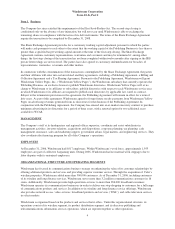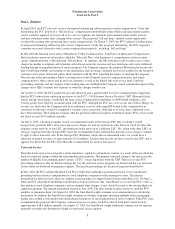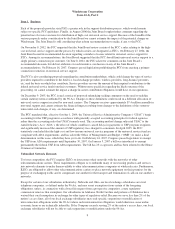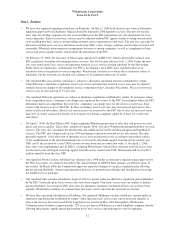Windstream 2006 Annual Report Download - page 77
Download and view the complete annual report
Please find page 77 of the 2006 Windstream annual report below. You can navigate through the pages in the report by either clicking on the pages listed below, or by using the keyword search tool below to find specific information within the annual report.
Windstream Corporation
Form 10-K, Part I
Item 1. Business
• In July 2005, our regulated Pennsylvania subsidiary began operating under a new alternative regulation plan
passed by the Pennsylvania General Assembly in 2004. Under this plan, we are required to make broadband
Internet access available for purchase to 100% of our customer base by 2013. The plan also limits rate increases to
the GDP-PI less 2%, annually. Rates for services the PSC has deemed to be competitive based on demonstrated
availability of like or substitute services offered by alternative service providers are not regulated, but the public
utility commission retains authority over the quality of these services. Revenue neutral rate rebalancing is also
permitted for services not deemed competitive by the PSC.
• Our regulated South Carolina operations are subject to alternative regulation established by statute. Local rates can
be adjusted pursuant to an inflation-based index. All other service rates may be increased subject to a complaint
process for abuse of market position. The PSC has determined that any allegations of abuse of market position will
be investigated on a case-by-case basis. Rate increases become effective 14 days after filing.
• We have four operating subsidiaries in Texas. These subsidiaries are subject to alternative regulation established
by statute. Pursuant to the statute, basic local rates and intrastate network access rates are capped. In September
2005, the Texas Legislature adopted significant telecommunications reform legislation. This legislation created,
among other provisions, a statewide video franchise for telecommunications carriers, established a framework for
deregulation of the retail telecommunications services offered by incumbent local telecommunications carriers,
created requirements for incumbent local telecommunications carriers to reduce intrastate access charges upon the
deregulation of markets and directed the PSC to initiate a study of the Texas USF. The state legislature may further
address issues of importance to rural telecommunications carriers in Texas, including the Texas USF, in the 2007
legislative session.
Universal Service
We receive USF support in a limited number of states in which we operate. In 2006, Windstream received $83.6 million
in state universal service support excluding the support received by Valor prior to the merger. These payments are
intended to provide additional support, beyond the federal universal service receipts, for the high cost of operating in rural
markets. For the year ended December 31, 2006, Windstream received approximately $56.0 million from the Texas USF
excluding the support received by Valor prior to the merger. The purpose of the Texas USF is to assist
telecommunications providers in providing basic local telecommunications services at reasonable rates to customers in
high cost rural areas and to qualifying low-income and disabled customers. By order of the Texas PSC, the Texas USF
distributes support to eligible carriers serving areas identified as high cost, on a per-line basis. Texas USF support
payments are based on the number of actual lines in service and therefore are subject to reductions when customers
discontinue service or migrate to a competitive carrier. All customers of telecommunications services in Texas contribute
to the Texas USF through the payment of a monthly surcharge by their customers. The rules governing the Texas USF
provide for a review of the Texas USF every three years starting in 1999. In September 2002, the Texas PSC undertook its
first review. In September 2003, the Texas PSC recommended no changes to the Texas USF. In September 2005, the
Texas Legislature adopted significant telecommunications reform legislation. Part of that legislation directed the Texas
PSC to initiate a study of the Texas USF and to make a report to the Texas Legislature. In addition, the 2005 legislation
precludes the Texas PSC from undertaking any proceeding to reduce Texas USF support until after September 1, 2007.
The Texas PSC completed its review and issued its report to the 2007 Texas Legislature in December 2006. The report
recommended that the high-cost program for small companies should be reviewed further regarding such issues as
reasonableness of basic local service rates as well as which lines should be eligible for support. Windstream receives
approximately $12.0 million annually from this program. The report also concluded that the high-cost program for large
companies should be updated and that the Texas PSC conduct a contested case or rulemaking under current law to
consider, at a minimum, any appropriate re-sizing and re-targeting of support. Such a proceeding is not expected to be
initiated until the third quarter of 2007. Windstream receives approximately $99.0 million from this program. The
Company cannot estimate at this time the financial impact resulting from changes, if any, to the high-cost programs.
Other Regulations
Under applicable state regulations, some of our subsidiaries are required to obtain the applicable state commission
approval for, or are subject to limitations on, any issuance of stock, incurrence of long term debt, payment of
dividends, acquisition or sale of material utility asset or any change in control of these subsidiaries or their parent
companies. Limits on dividends have not had any impact on the Company.
13
























